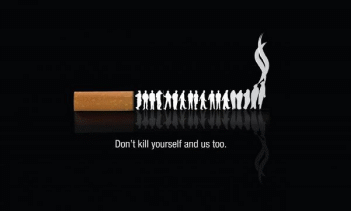Background Information
Smoking is responsible for over 440,000 deaths annually in the United States. A similar number of casualties occur in different parts of the world. Smoking is also “associated with different health problems such cancer, respiratory complications, and lung infections” (Ji, Xiong, Gilpin, & Biener, 2007, p. 34). Every society should create appropriate anti-smoking adverts because they have the potential to deal with the issue of tobacco use.
The loss of individuals due to tobacco use affects the economy of many societies. Many children in the developed world lose their guardians yearly due to smoking (Sachs, 2010). These statistics encourage every society to use the best anti-smoking ads in order to deal with the vice. This persuasive essay explains why anti-smoking adverts are effective towards dealing with smoking.
Studies have proved that “hard-hitting campaigns and adverts can produce positive results” (Ji et al., 2007, p. 29). Sachs (2010) believes strongly that appropriate anti-tobacco adverts can be useful towards addressing this problem. According to Sachs (2010, p. 59), a good advert “stimulates negative emotions thus encouraging more citizens to quit smoking”.
Arguments against the Use of Anti-Smoking Campaigns
Many scholars “believe that anti-smoking campaigns are incapable of achieving their goals” (Ji et al., 2007, p. 29). This situation explains why our societies have failed to address the problem of smoking. Many people believe that anti-smoking campaigns are usually ineffective. According to Pampel (2009, p. 28), “different youths will ignore every anti-smoking advert”. Some scholars explain why televisions ads do not encourage people to quit smoking.
It is agreeable that “many smokers take a long time before quitting” (Pampel, 2009, p. 54). People will always be imperfect. Human beings will also embrace negative behaviors such as drinking and smoking. That being the case, the decision to illegalize cigarettes cannot produce the best results. Human beings will always make different mistakes.
Pampel (2009) believes that many anti-smoking adverts are ineffective. This fact explains why many people respond negatively to every anti-smoking advert. Peer pressure also encourages more youths to use different drugs. That being the case, anti-smoking ads do not play a major role towards dealing with this problem. Some scholars explain why the decision to illegalize cigarettes can deal with this problem. The above arguments describe why our societies ignore the use of different anti-smoking adverts. Many opponents embrace the use of legal measures (Pampel, 2009).
Counterarguments: The Effectiveness of Anti-Smoking Campaigns
I strongly believe that effective anti-smoking campaigns can make a huge difference in every society. Our societies should identify the best messages in order to educate more citizens. The Florida Department of Health (FDOH) initiated a new campaign to educate the youth about the dangers of smoking (Sachs, 2010). The campaign embraced the use of aggressive ads. The approach sensitized more people about the dangers of smoking. This successful campaign encouraged hundreds of citizens to quit smoking (Bajde & Vida, 2009).
Adequate media campaigns can also discourage more youths from using hardcore drugs. The practice also “reduces the rate youth tobacco initiation” (Ji et al., 2007, p. 35). The graph below explains how anti-tobacco adverts have produced positive results in the United States.

Graphic images are useful towards education more people about the health implications of cigarettes. For instance, effective ads should explain how our children lose their parents due to smoking. Such “adverts are essential towards reinforcing a person’s desire to stop using cigarettes” (Bajde & Vida, 2009, p. 85). According to a study by Liu and Tan (2009), effective adverts and campaigns have the potential to touch the lives of many people. Such adverts should also analyze how smoking causes different disabilities. This fact explains why powerful anti-smoking advertisements have the potential to address this problem.
Campaigns and adverts showing the implications of smoking can encourage more adults to quit smoking. Such adverts also discourage young people from embracing the vice. According to Liu and Tan (2009, p. 33), “many smokers can quit smoking after seeing several emotional adverts”. This situation explains why “personal testimonies and highly emotional advertisements can encourage more individuals to quit smoking” (Liu & Tan, 2009, p. 34). Strong efficacy messages have the potential to produce good results.
According to Bajde and Vida (2009, p. 81), “teenagers and youths will always establish their unique subcultures”. Such youths also embrace the use of tobacco and other addictive drugs. Every good advert must focus on the best strategies towards sensitizing these youths. The advert presented below has sensitized many people about the dangers of smoking. We must create similar adverts in order to achieve the best goals.

Recommendations for Future Practice
Although “anti-tobacco campaigns can be effective towards dealing with this problem, the biggest concern is why a large number of citizens are still smoking today” (Liu & Tan, 2009, p. 43). Many adverts fail to address the challenges affecting our young people. For example, many youths do not care about their lives. Some adverts “have portrayed old men with wrinkled skins and rotten teeth” (Bajde & Vida, 2009, p. 86). Such adverts encourage the youth to continue smoking because they might not die soon. A good advert must describe how smoking is capable of causing death. This approach will eventually address the health issues associated with tobacco.

The number of smokers is still increasing in different parts of the world. Most of the existing laws have failed to address this challenge. The important thing is for every society to identify the best messages in an attempt to deal with the problem. Our governments should also support different anti-smoking campaigns (Liu & Tan, 2009). Every advert should also deliver the right message to the targeted audience.
Our societies should produce powerful adverts that can communicate to every citizen. The “best approach towards achieving this goal is by using televisions, newspapers, radios, and billboards” (Bajde & Vida, 2009, p. 85). The other challenge is that many adverts are unsustainable. Many anti-tobacco campaigns are usually short-lived. Such ads are ineffective towards informing more people about the consequences of smoking. The government has failed to support different agencies and organizations. This situation has made it impossible for such agencies to deal with the problem of smoking.
The agreeable fact is that anti-smoking ads are effective. Such adverts can produce positive results if our society embraces the best practices. Every advert should target both males and females in order to deal with the issue. Such adverts should also encourage more teenagers to avoid different drugs such as marijuana and heroin (Liu & Tan, 2009). Such addictive drugs encourage the youth to use tobacco and alcohol. In conclusion, different players must come together in order to deal with this problem.
Reference List
Bajde, D., & Vida, I. (2009). The Impact of Ad Characteristics on Adolescents’ Attitudes towards Antismoking Ads. Managing Global Transitions, 6(1), 75-93.
Ji, M., Xiong, C., Gilpin, E., & Biener, L. (2007). Assessing the Effectiveness of Anti-smoking Media Campaigns by Recall and Rating Scores: A Pattern-Mixture GEE Model Approach. Journal of Data Science, 5(1), 23-40.
Liu, H., & Tan, W. (2009). The Effect of Anti-Smoking Media Campaign on Smoking Behavior: The California Experience. Annals of Economics and Finance, 10(1), 29-47.
Pampel, F. (2009). Tobacco Industry and Smoking. New York, NY: Infobase Publishing.
Sachs, K. (2010). Up in Smoke: How Antismoking Advertisements Have Changed Youth Smoking Habits. The Elon Journal of Undergraduate Research in Communications, 1(1), 58-69.